Order-6-4 triangular honeycomb
In the geometry of hyperbolic 3-space, the order-6-4 triangular honeycomb is a regular space-filling tessellation (or honeycomb) with Schläfli symbol {3,6,4}.
Geometry
It has four triangular tiling {3,6} around each edge. All vertices are ultra-ideal (existing beyond the ideal boundary) with infinitely many triangular tilings existing around each vertex in an order-4 hexagonal tiling vertex arrangement.
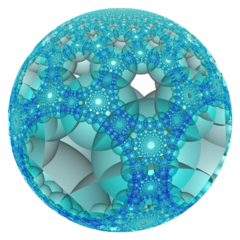 Poincaré disk model |
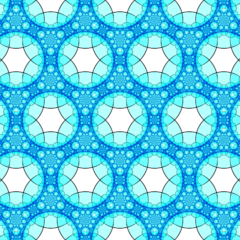 Ideal surface |
It has a second construction as a uniform honeycomb, Schläfli symbol {3,61,1}, Coxeter diagram, ![]()
![]()
![]()
![]()
![]() , with alternating types or colors of triangular tiling cells. In Coxeter notation the half symmetry is [3,6,4,1+] = [3,61,1].
, with alternating types or colors of triangular tiling cells. In Coxeter notation the half symmetry is [3,6,4,1+] = [3,61,1].
Related polytopes and honeycombs
It a part of a sequence of regular polychora and honeycombs with triangular tiling cells: {3,6,p}
Order-6-5 triangular honeycomb
| Order-6-5 triangular honeycomb | |
|---|---|
| Type | Regular honeycomb |
| Schläfli symbol | {3,6,5} |
| Coxeter diagram | |
| Cells | {3,6} |
| Faces | {3} |
| Edge figure | {5} |
| Vertex figure | {6,5} |
| Dual | {5,6,3} |
| Coxeter group | [3,6,5] |
| Properties | Regular |
In the geometry of hyperbolic 3-space, the order-6-3 triangular honeycomb is a regular space-filling tessellation (or honeycomb) with Schläfli symbol {3,6,5}. It has five triangular tiling, {3,6}, around each edge. All vertices are ultra-ideal (existing beyond the ideal boundary) with infinitely many triangular tilings existing around each vertex in an order-5 hexagonal tiling vertex arrangement.
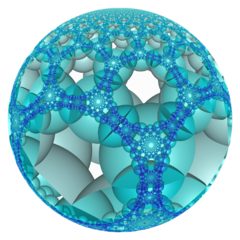 Poincaré disk model |
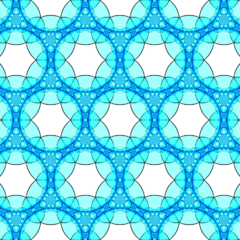 Ideal surface |
Order-6-6 triangular honeycomb
In the geometry of hyperbolic 3-space, the order-6-6 triangular honeycomb is a regular space-filling tessellation (or honeycomb) with Schläfli symbol {3,6,6}. It has infinitely many triangular tiling, {3,6}, around each edge. All vertices are ultra-ideal (existing beyond the ideal boundary) with infinitely many triangular tilings existing around each vertex in an order-6 triangular tiling vertex arrangement.
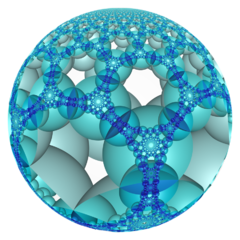 Poincaré disk model |
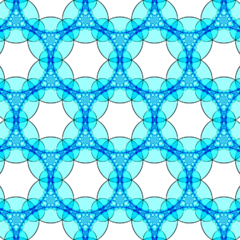 Ideal surface |
It has a second construction as a uniform honeycomb, Schläfli symbol {3,(6,3,6)}, Coxeter diagram, ![]()
![]()
![]()
![]()
![]()
![]()
![]() =
= ![]()
![]()
![]()
![]()
![]() , with alternating types or colors of triangular tiling cells. In Coxeter notation the half symmetry is [3,6,6,1+] = [3,((6,3,6))].
, with alternating types or colors of triangular tiling cells. In Coxeter notation the half symmetry is [3,6,6,1+] = [3,((6,3,6))].
Order-6-infinite triangular honeycomb
| Order-6-infinite triangular honeycomb | |
|---|---|
| Type | Regular honeycomb |
| Schläfli symbols | {3,6,∞} {3,(6,∞,6)} |
| Coxeter diagrams | |
| Cells | {3,6} |
| Faces | {3} |
| Edge figure | {∞} |
| Vertex figure | {6,∞} {(6,∞,6)} |
| Dual | {∞,6,3} |
| Coxeter group | [∞,6,3] [3,((6,∞,6))] |
| Properties | Regular |
In the geometry of hyperbolic 3-space, the order-6-infinite triangular honeycomb is a regular space-filling tessellation (or honeycomb) with Schläfli symbol {3,6,∞}. It has infinitely many triangular tiling, {3,6}, around each edge. All vertices are ultra-ideal (existing beyond the ideal boundary) with infinitely many triangular tilings existing around each vertex in an infinite-order triangular tiling vertex arrangement.
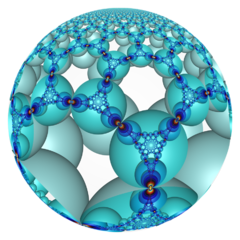 Poincaré disk model |
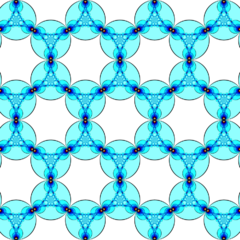 Ideal surface |
It has a second construction as a uniform honeycomb, Schläfli symbol {3,(6,∞,6)}, Coxeter diagram, ![]()
![]()
![]()
![]()
![]()
![]()
![]() =
= ![]()
![]()
![]()
![]()
![]()
![]() , with alternating types or colors of triangular tiling cells. In Coxeter notation the half symmetry is [3,6,∞,1+] = [3,((6,∞,6))].
, with alternating types or colors of triangular tiling cells. In Coxeter notation the half symmetry is [3,6,∞,1+] = [3,((6,∞,6))].
See also
- Convex uniform honeycombs in hyperbolic space
- List of regular polytopes
References
- Coxeter, Regular Polytopes, 3rd. ed., Dover Publications, 1973. ISBN:0-486-61480-8. (Tables I and II: Regular polytopes and honeycombs, pp. 294–296)
- The Beauty of Geometry: Twelve Essays (1999), Dover Publications, LCCN 99-35678, ISBN:0-486-40919-8 (Chapter 10, Regular Honeycombs in Hyperbolic Space) Table III
- Jeffrey R. Weeks The Shape of Space, 2nd edition ISBN:0-8247-0709-5 (Chapters 16–17: Geometries on Three-manifolds I, II)
- George Maxwell, Sphere Packings and Hyperbolic Reflection Groups, JOURNAL OF ALGEBRA 79,78-97 (1982) [1]
- Hao Chen, Jean-Philippe Labbé, Lorentzian Coxeter groups and Boyd-Maxwell ball packings, (2013)[2]
- Visualizing Hyperbolic Honeycombs arXiv:1511.02851 Roice Nelson, Henry Segerman (2015)
External links
- Spherical Video: {3,6,∞} honeycomb with parabolic Möbius transform YouTube, Roice Nelson
- John Baez, Visual insights: {7,3,3} Honeycomb (2014/08/01) {7,3,3} Honeycomb Meets Plane at Infinity (2014/08/14)
- Danny Calegari, Kleinian, a tool for visualizing Kleinian groups, Geometry and the Imagination 4 March 2014. [3]
 |



